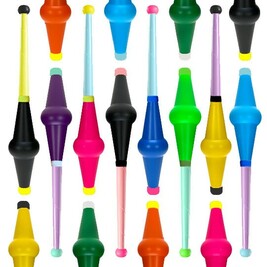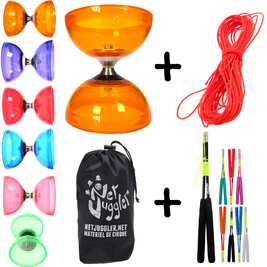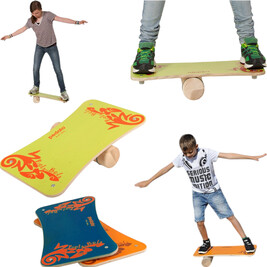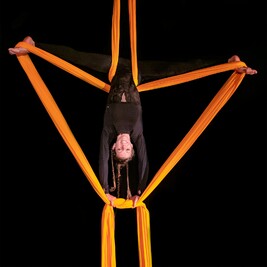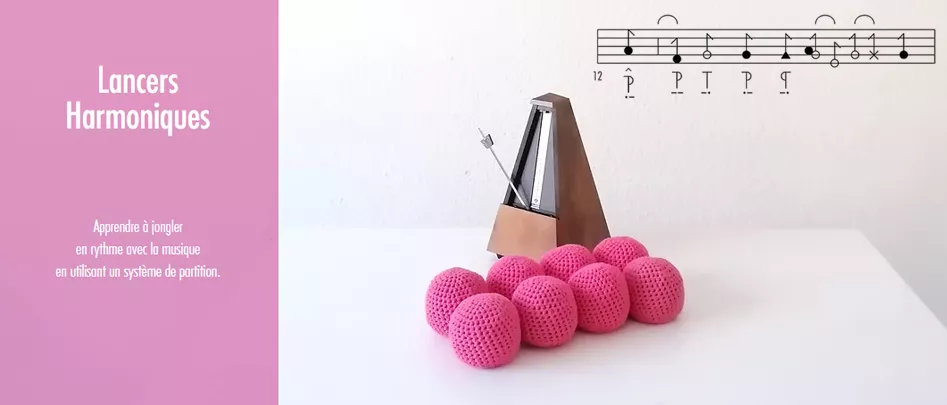
Juggling and Music: A New Score
Juggling isn't just about agility and dexterity. In an interview, Jonathan reveals how he gave this art a new dimension by developing a teaching approach based on fun, music, collaboration, and autonomy. Between a life story, a reflection on the juggling community, and a presentation of an innovative method, this encounter offers a unique insight into what juggling can be today.
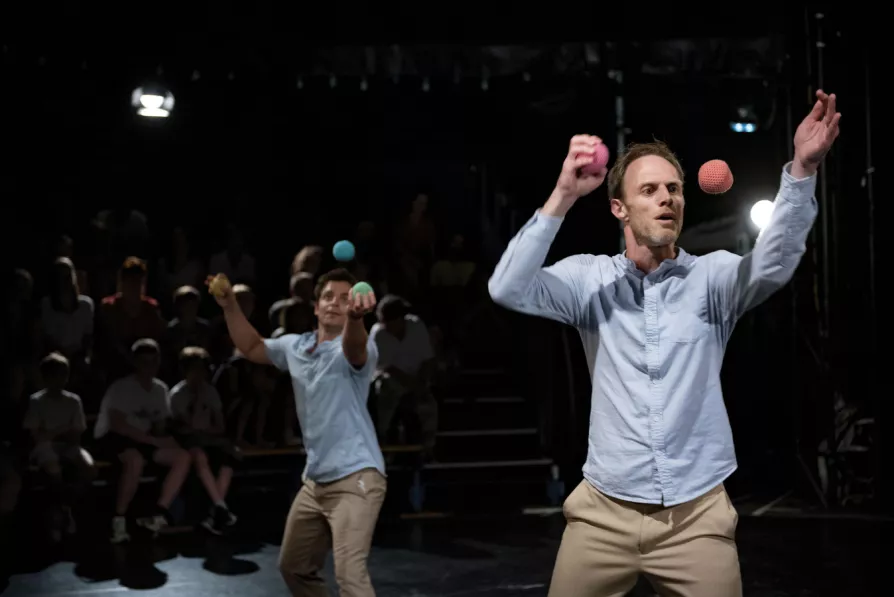
How I discovered juggling and how I decided to take it up do my job.
I discovered juggling in two stages.
A first when I saw a woman making flaming bolas in a park on my way home from a party. She was accompanied by a saxophonist. The two of them weren't playing for an audience, but for the pleasure of practicing their passion together. I watched them for a few minutes, and she suggested I try some basic moves on a bola. I was immediately hooked!
That same evening when I got home, I tried to make myself a pair of bolas to get started.
After that, I looked for as much information as possible about poispinning, I tried to meet people on the Internet and in real life. I discovered the BCC (Burn Crew Concept) the Parisian spinners. Already at that time, of course, the question of flow spoke to me a lot, but I mainly put my energy into analyzing and conceptualizing the technique specific to bolas. At the time I had set up a Skyblog serving as a dictionary of tricks to perform in GIF, with explanations and advice (Youtube did not yet exist).
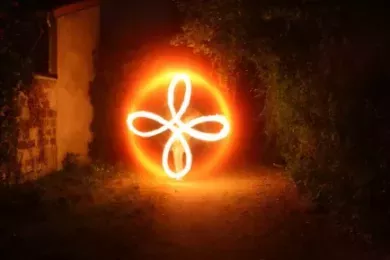
While going to spinner meetups, I met jugglers. At the time, I really wasn't at all attracted to "traditional" juggling, but some jugglers told me about site-swap. It really surprised and captivated me to see people facing lists of numbers as if they were facing little puzzles. That's how I started juggling balls first. So I started getting involved in this new Parisian community, full of people who were already very strong, or were going to become professional jugglers themselves.
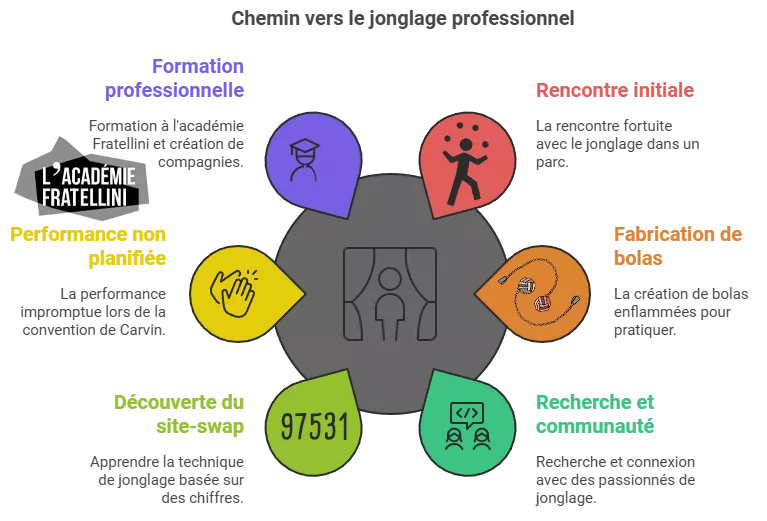
Shortly before I devoted all my time to BAM (balls, rings, clubs), I did an open stage at the 2007 Carvin convention. This performance on stage in front of passionate jugglers was not at all prepared, my registration for the program was done the same day. I spent my afternoon finding music and presentable clothes to go on stage. Finally, despite this lack of preparation, this open stage was a very enjoyable moment, and the audience rewarded me with a standing ovation. It was this event in particular that made me say to myself that I had to start thinking about becoming a professional juggler. It was a year later that I joined the Fratellini Academy to train professionally, joined the company of flying objects in 2012, and then created the company L'expédition in 2018.
How does your approach to juggling differ from other methods? traditional ones focused on technical figures?
A strong difference is that I have a clear goal when I juggle: to have fun and enjoy myself.
I see a lot of people juggling without really knowing why. Sometimes out of habit, others out of belonging to a group of friends, and still others in the more or less conscious hope that being good at juggling will bring them recognition in the future. When I go to a juggling festival, I see too many people "working" and not enough "having fun."
It seems to me that there is a real problem in the juggling community around this question. Learning traditional figures is, for many, and especially for beginners, something very thankless, off-putting, boring, confronts us too much with failure, and requires too much discipline for a result that is less and less encouraging, because the efforts required are more and more substantial and the rewards less and less regular as one progresses.
A good session is one from which I emerge refreshed, amused, with a smile, and at ease in my body and mind. To achieve this result, I set aside the approaches usually found among jugglers and studied different teaching approaches from other disciplines such as music, and then adapted them to learning juggling.
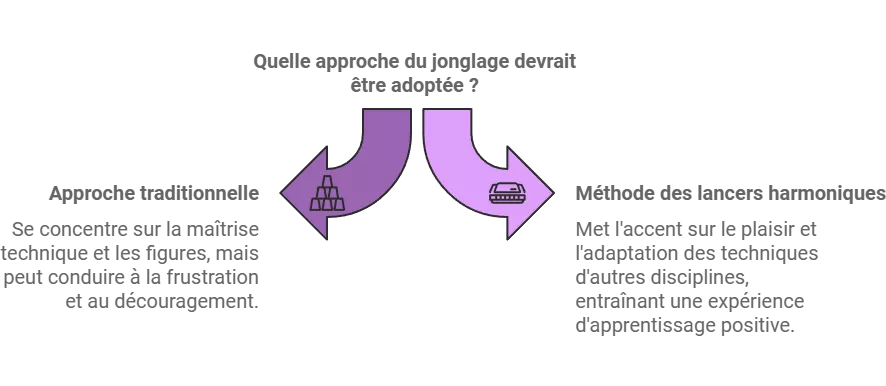
To develop this method, I tested class sessions on people of different levels, not to see if they had progressed, but if they had fun. It was by comparing my hypotheses with people's feelings that I developed the harmonic throwing method.
Music plays a central role in your method. How do you integrate musical rhythm into juggling training?
I see music as both a guide and a partner.
A guide, because if we seek to make music from our practice, it places us in a listening, an attention which helps us to remain attentive and therefore to see more easily the details to improve, but above all to immerse ourselves fully in the present moment and therefore in a certain form of happiness.
A partner, because with music, you no longer work alone, but rather listen to something outside of yourself. This prepares you for meetings with those who make the music, the musicians (or people practicing musical juggling). Preparing for these meetings allows you to better enjoy moments of collective sharing.
Can you explain the writing system you developed for juggling and how it facilitates access to the choreographic repertoire?
The method is accompanied by a writing system. It resembles music theory graphically and conceptually. The goal is to transcribe into writing what you enjoy juggling. And as in music, juggling is easier to convey in writing than dictated orally.
As with music, it is not essential to know how to read sheet music, but it does have some significant advantages.
- This allows access to a repertoire , that is, to pleasant sequences written by others. So it relieves us of the obligation of having to compose the sequences ourselves .
- Better preservation and dissemination of its pleasant sequences .
- This allows for harmonization of language and therefore better communication between jugglers .
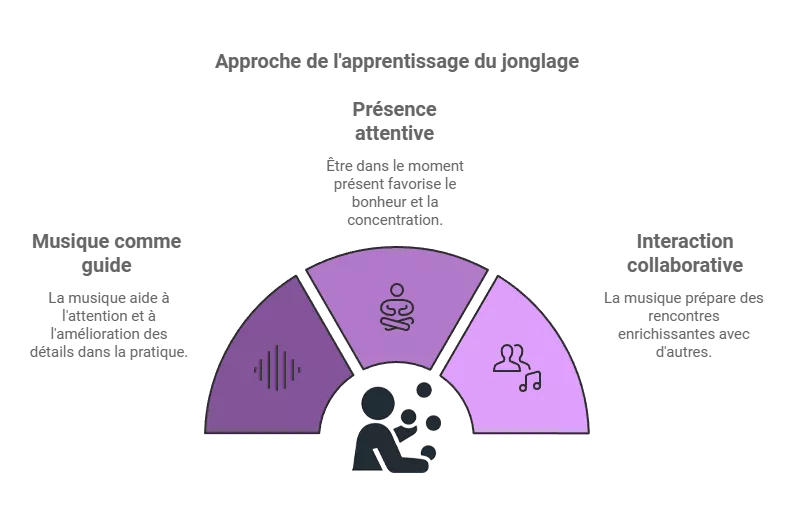
Your method emphasizes collaboration with other artists. How do you think working in a group enriches juggling?
Like many people, I enjoy practicing my passion, and I get even more satisfaction from it when I practice with other enthusiasts. This is partly why I developed MLH, it's mainly to practice with others. :)
Practicing pulsed juggling allows for simpler and more direct artistic and human encounters.
You created the show "TACOMA" in just five weeks using your method. What challenges did you encounter during this creation?
The creation of this show was in itself a challenge to test the method and system of scoring harmonic throws.
If all the performers are trained in MLH, then we can each work individually on the technical parts, and only take the collective times to explore new ideas or staging. So we took 5 weeks together, but interspersed with a month of individual rehearsals each at home. We therefore had plenty of time to learn each of our scores at our own speed and in our own way. This allowed us to be much more available during our reunions, and therefore the collective times were always very pleasant and creative.
Your method seems to encourage autonomy and creativity. How do you guide jugglers to develop their own style?
First of all, let's remember that having your own style isn't a requirement. I'm saying this here because I find this idea too prevalent and puts a lot of pressure on everyone, from beginners to experienced jugglers.
As in music, where playing the same pieces already played by many people can be a source of pleasure, we should be able to enjoy already existing juggling without having to write our own routines or create our own figures to enjoy juggling.
The question that comes up in all our interviews during your performances is: how do you handle "drops" (when the balls fall)? Do you integrate them into your shows or do you see them as mistakes to absolutely avoid?
Now that we know that I defend the idea of juggling for fun, and even more so in a group, of course dropping is something I don't want on stage.


I hear the idea that the drop can be a source of improvisation, an opportunity to be part of the present. But it seems that this discourse, in many cases, is a posture adopted to better experience the drop perceived as inevitable.
I want to make it clear that it is possible to practice "dropless" juggling, and that it is an incredible and easily accessible source of personal and collective satisfaction.
The question that now arises is: how do you avoid dropping your balls? Quite simply by choosing easy and enjoyable exercises and sequences. And as in music, it is by spending all your practice time succeeding that you have a good chance of succeeding on stage (and worse, it is by repeating the same mistakes that you anchor them in yourself and that they come out on stage…). That being said, despite all the precautions taken, it is always possible that a drop happens on stage. Practicing Harmonic Throws allows you to have a better knowledge of your score, and therefore not to be confused, and to be able to pick it up along the way.
How do you see the evolution of contemporary juggling and what is your vision for the future of this discipline?
I see a positive evolution on the human level. There's less competition, and more room is being made for everyone, even if the journey isn't over yet. But alongside that, it seems to me that people are losing knowledge, reflection, and conceptualization.
I hope to see the juggling community not shy away from the issues facing society, without forgetting the technical and artistic research that allowed it to come into being.
Can you share a significant experience in your career that influenced your artistic approach?
One of the most powerful moments I've experienced in recent years happened at the 2019 Glühwein Convention.
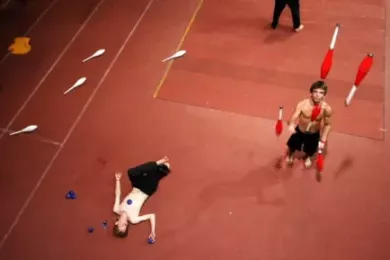
One evening, Christelle Herscher, as the evening's DJ, served us perfect music for juggling. I was doing an improvisation session with Vincent Manguaud, when several jugglers sat in a circle around us, transforming this intimate game session into a small show. Then other jugglers participated in this jam, then other spectators, to make a hundred people after 2 hours of jamming, with the shared impression of experiencing a communion rarely experienced between jugglers, and an unequaled pleasure of being together, connected by the music of one of our own, around our passion.
Everyone felt welcome to enter the circle, everyone supported those who offered something. We were a mass with eyes and ears filled with happiness.
This is a memory that regularly invites me to share my vision of juggling in rhythm with music.
What advice would you give to someone who is new to juggling and wants to use your method?
That you have to go slowly and with pleasure. Doing short, regular sessions, paying attention to whether you enjoy doing a particular exercise or not, will increase your chances of progressing, but above all, of having a good time.
What are your future plans with the company L'Expédition and do you plan to publish other works on juggling?
The expedition develops 3 main axes :
- The production of shows by regularly creating shows combining juggling and music .
- The ecological transition , by rethinking the means of production , distribution and show equipment . This also makes it possible to produce ethical and environmentally friendly juggling balls .
- Pedagogy , by regularly offering courses , MOOCs , and publishing the harmonic throwing method in book form .
Volume 1 was released last year (available on the NetJuggler website) and volume 2 is available for pre-order via an Ulule campaign . If you want to support this project , now is the time!

You've turned your passion into your profession. What advice do you wish you'd had when you were starting out? What advice would you give to young people who want to make juggling their career?
I don't know if it was really me who decided it. What seems important to me is to go on stage !
There are plenty of conventions that offer open stages, they're made for that! Suggest something simple, whatever your level, first to see if you like it (because loving juggling doesn't necessarily mean juggling on stage). Like everything, it's by regularly practicing something you love that you progress and flourish.
Thank you Jonathan!
Thank you for your words, Jonathan, and for taking the time to share with us! This interview is a reminder that juggling is much more than a technical discipline. Through Jonathan's words, we discover a universe where musicality, cooperation, and respect for the environment become pillars. A harmonious approach that inspires us to further enrich our practices, support the projects we're working on, and take part in the collective adventure of tomorrow's juggling.
Comments
!Be the First to comment!
Quartz diabolo kit + Accessories
Triple bearing diabolo, Superglass sticks, 10m Henrys string and bag!

